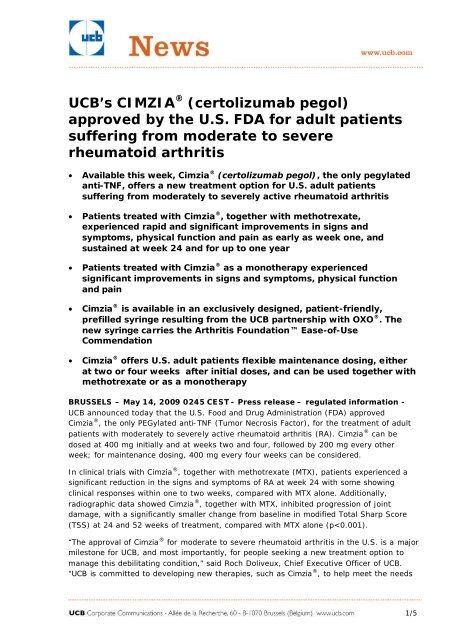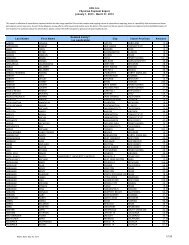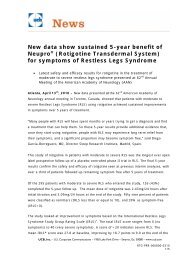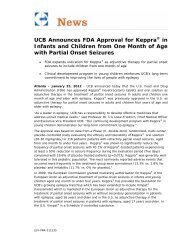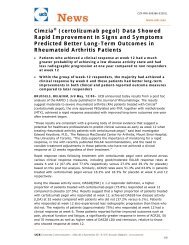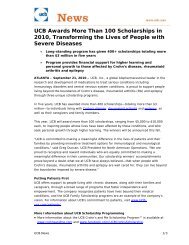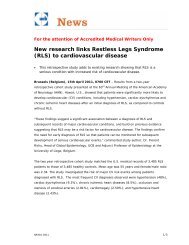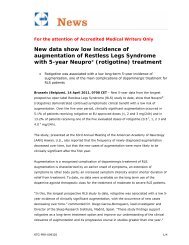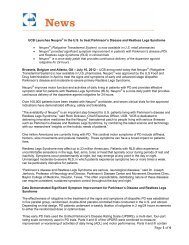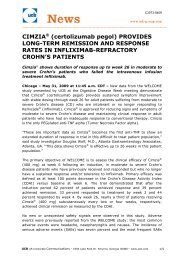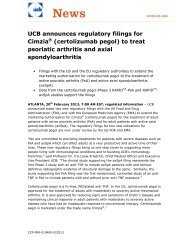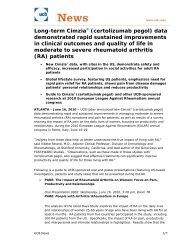UCB's CIMZIA (certolizumab Pegol)
UCB's CIMZIA (certolizumab Pegol)
UCB's CIMZIA (certolizumab Pegol)
You also want an ePaper? Increase the reach of your titles
YUMPU automatically turns print PDFs into web optimized ePapers that Google loves.
UCB’s <strong>CIMZIA</strong> ® (<strong>certolizumab</strong> pegol)<br />
approved by the U.S. FDA for adult patients<br />
suffering from moderate to severe<br />
rheumatoid arthritis<br />
• Available this week, Cimzia ® (<strong>certolizumab</strong> pegol), the only pegylated<br />
anti-TNF, offers a new treatment option for U.S. adult patients<br />
suffering from moderately to severely active rheumatoid arthritis<br />
• Patients treated with Cimzia ® , together with methotrexate,<br />
experienced rapid and significant improvements in signs and<br />
symptoms, physical function and pain as early as week one, and<br />
sustained at week 24 and for up to one year<br />
• Patients treated with Cimzia ® as a monotherapy experienced<br />
significant improvements in signs and symptoms, physical function<br />
and pain<br />
• Cimzia ® is available in an exclusively designed, patient-friendly,<br />
prefilled syringe resulting from the UCB partnership with OXO ® . The<br />
new syringe carries the Arthritis Foundation Ease-of-Use<br />
Commendation<br />
• Cimzia ® offers U.S. adult patients flexible maintenance dosing, either<br />
at two or four weeks after initial doses, and can be used together with<br />
methotrexate or as a monotherapy<br />
BRUSSELS – May 14, 2009 0245 CEST - Press release – regulated information -<br />
UCB announced today that the U.S. Food and Drug Administration (FDA) approved<br />
Cimzia ® , the only PEGylated anti-TNF (Tumor Necrosis Factor), for the treatment of adult<br />
patients with moderately to severely active rheumatoid arthritis (RA). Cimzia ® can be<br />
dosed at 400 mg initially and at weeks two and four, followed by 200 mg every other<br />
week; for maintenance dosing, 400 mg every four weeks can be considered.<br />
In clinical trials with Cimzia ® , together with methotrexate (MTX), patients experienced a<br />
significant reduction in the signs and symptoms of RA at week 24 with some showing<br />
clinical responses within one to two weeks, compared with MTX alone. Additionally,<br />
radiographic data showed Cimzia ® , together with MTX, inhibited progression of joint<br />
damage, with a significantly smaller change from baseline in modified Total Sharp Score<br />
(TSS) at 24 and 52 weeks of treatment, compared with MTX alone (p
of patients living with rheumatoid arthritis and other immune diseases. I am also proud of<br />
our partnership with OXO ® and of the fact that RA patients were directly involved in the<br />
design and development of our new prefilled syringe, which is designed to make selfadministration<br />
easy for people living with rheumatoid arthritis.”<br />
The new prefilled Cimzia ® syringe is now also available for subcutaneous selfadministration<br />
to U.S. patients with moderate to severe Crohn’s disease who have had an<br />
inadequate response to conventional therapy.<br />
The FDA approval is based on UCB’s comprehensive clinical program, including data from<br />
four multi-center placebo-controlled phase III trials, involving more than 2 300 patients<br />
with RA and over 4 000 patient-years experience. Cimzia ® has been studied at dosing<br />
intervals of two or four weeks, and administered together with MTX or as monotherapy.<br />
In the pivotal clinical trials, reported serious adverse reactions were infections including<br />
tuberculosis and malignancies including lymphoma. The most commonly occurring<br />
adverse events were upper respiratory tract infections, rash and urinary tract infections. A<br />
pooled analysis of the safety data show there was a low incidence of injection site pain<br />
(
About <strong>CIMZIA</strong> ®<br />
Cimzia ® is the only PEGylated anti-TNF (Tumor Necrosis Factor). Cimzia ® has a high affinity<br />
for human TNF-alpha, selectively neutralizing the pathophysiological effects of TNF-alpha.<br />
Over the past decade, TNF-alpha has emerged as a major target of basic research and<br />
clinical investigation. This cytokine plays a key role in mediating pathological inflammation,<br />
and excess TNF-alpha production has been directly implicated in a wide variety of diseases.<br />
The U.S. Food and Drug Administration (FDA) has approved Cimzia ® for reducing signs and<br />
symptoms of Crohn's disease and maintaining clinical response in adult patients with<br />
moderate to severe active disease who have had an inadequate response to conventional<br />
therapy and for the treatment of adults with moderate to severely active rheumatoid<br />
arthritis. Cimzia ® was approved in Switzerland for induction of a clinical response and for<br />
the maintenance of a clinical response and remission in patients with active Crohn’s disease<br />
who have not responded adequately to conventional treatment in September 2007. UCB is<br />
also developing Cimzia ® in other autoimmune disease indications. Cimzia ® is a registered<br />
trademark of UCB PHARMA S.A.<br />
OXO and GOOD GRIPS are trademarks of Helen of Troy Limited (NASDAQ HELE) and are used under<br />
license<br />
IMPORTANT SAFETY INFORMATION<br />
Patients treated with <strong>CIMZIA</strong> are at an increased risk for developing serious infections<br />
that may lead to hospitalization or death. Most patients who developed these infections<br />
were taking concomitant immunosuppressants such as methotrexate or corticosteroids.<br />
<strong>CIMZIA</strong> should be discontinued if a patient develops a serious infection or sepsis.<br />
Reported infections include:<br />
• Active tuberculosis, including reactivation of latent tuberculosis. Patients with<br />
tuberculosis have frequently presented with disseminated or extrapulmonary<br />
disease. Patients should be tested for latent tuberculosis before <strong>CIMZIA</strong> use and<br />
during therapy. Treatment for latent infection should be initiated prior to <strong>CIMZIA</strong><br />
use.<br />
• Invasive fungal infections, including histoplasmosis , coccidioidomycosis,<br />
candidiasis, aspergillosis, blastomycosis, and pneumocystosis. Patients with<br />
histoplasmosis or other invasive fungal infections may present with disseminated,<br />
rather than localized disease. Antigen and antibody testing for histoplasmosis may<br />
be negative in some patients with active infection. Empiric anti-fungal therapy<br />
should be considered in patients at risk for invasive fungal infections who develop<br />
severe systemic illness .<br />
• Bacterial, viral and other infections due to opportunistic pathogens.<br />
The risks and benefits of treatment with <strong>CIMZIA</strong> should be carefully considered prior to<br />
initiating therapy in patients with chronic or recurrent infection. Patients should be<br />
closely monitored for the development of signs and symptoms of infection during and<br />
after treatment with <strong>CIMZIA</strong>, including the possible development of tuberculosis in<br />
patients who tested negative for latent tuberculosis infection prior to initiating therapy.<br />
Serious and sometimes fatal infection due to bacterial, mycobacterial, invasive fungal, viral or other<br />
opportunistic pathogens has been reported in patients receiving TNF-blocking agents. Among<br />
opportunistic infections, tuberculosis, histoplasmosis, aspergillosis, candidiasis, coccidioidomycosis,<br />
listeriosis, and pneumocystosis were the most common. Treatment with <strong>CIMZIA</strong> should not be<br />
initiated in patients with an active infection, including clinically important localized infections. The<br />
risks and benefits of treatment should be considered prior to initiating therapy in patients with<br />
chronic or recurrent infection, who have been exposed to tuberculosis, who have resided or traveled<br />
in areas of endemic tuberculosis or endemic mycoses, such as histoplasmosis, coccidioidomycosis, or<br />
blastomycosis, or with underlying conditions that may predispose them to infection.<br />
Patients should be evaluated for tuberculosis risk factors and tested for latent infection prior to<br />
initiating <strong>CIMZIA</strong> and periodically during therapy. Patients should be closely monitored for the<br />
development of signs and symptoms of infections during and after treatment with <strong>CIMZIA</strong>, including<br />
development of tuberculosis in patients who tested negative for latent tuberculosis infection prior to<br />
initiating therapy. <strong>CIMZIA</strong> should be discontinued if a patient develops a serious infection or sepsis.<br />
Patients who develop a new infection during treatment with <strong>CIMZIA</strong> should be closely monitored,<br />
UCB News 3/5
undergo a prompt and complete diagnostic workup appropriate for immunocompromised patients,<br />
and appropriate antimicrobial therapy should be initiated. Appropriate empiric antifungal therapy<br />
should also be considered while a diagnostic workup is performed for patients who develop a serious<br />
systemic illness and reside or travel in regions where mycoses are endemic.<br />
During controlled and open-labeled portions of <strong>CIMZIA</strong> studies of Crohn’s disease and other<br />
diseases, malignancies (excluding non-melanoma skin cancer) were observed at a rate (95%<br />
confidence interval) of 0.5 (0.4, 0.7 ) per 100 patient-years among 4,650 <strong>CIMZIA</strong>-treated patients<br />
versus a rate of 0.6 (0.2, 1.7) per 100 patient-years among 1,319 placebo-treated patients. The size<br />
of the control group and limited duration of the controlled portions of the studies preclude the ability<br />
to draw firm conclusions. In studies of <strong>CIMZIA</strong> for Crohn’s disease and other investigational uses,<br />
there was one case of lymphoma among 2,657 <strong>CIMZIA</strong>-treated patients and one case of Hodgkin<br />
lymphoma among 1,319 placebo-treated patients. In <strong>CIMZIA</strong> RA clinical trials (placebo-controlled<br />
and open label) a total of three cases of lymphoma were observed among 2,367 patients. This is<br />
approximately 2-fold higher than expected in the general population. Patients with RA, particularly<br />
those with highly active disease, are at a higher risk for the development of lymphoma. The<br />
potential role of TNF blocker therapy in the development of malignancies is not known.<br />
Cases of worsening congestive heart failure (CHF) and new onset CHF have been reported with TNF<br />
blockers. <strong>CIMZIA</strong> has not been formally studied in patients with CHF. Exercise caution when using<br />
<strong>CIMZIA</strong> in patients who have heart failure and monitor them carefully.<br />
Symptoms compatible with hypersensitivity reactions, including angioedema, dyspnea, hypotension,<br />
rash, serum sickness, and urticaria, have been reported rarely following <strong>CIMZIA</strong> administration. If<br />
such reactions occur, discontinue further administration of <strong>CIMZIA</strong> and institute appropriate therapy.<br />
Use of TNF blockers, including <strong>CIMZIA</strong>, may increase the risk of reactivation of hepatitis B virus<br />
(HBV) in patients who are chronic carriers of this virus. Some cases have been fatal. Evaluate<br />
patients at risk for HBV infection for prior evidence of HBV infection before initiating <strong>CIMZIA</strong> therapy.<br />
Exercise caution in prescribing <strong>CIMZIA</strong> for patients identified as carriers of HBV. Patients who are<br />
carriers of HBV and require treatment with <strong>CIMZIA</strong> should be closely monitored for clinical and<br />
laboratory signs of active HBV infection throughout therapy and for several months following<br />
termination of therapy. In patients who develop HBV reactivation, discontinue <strong>CIMZIA</strong> and initiate<br />
effective anti-viral therapy with appropriate supportive treatment.<br />
Use of TNF blockers, including <strong>CIMZIA</strong>, has been associated with rare cases of new onset or<br />
exacerbation of clinical symptoms and/or radiographic evidence of demyelinating disease. Rare<br />
cases of neurological disorders, including seizure disorder, optic neuritis, and peripheral neuropathy<br />
have been reported in patients treated with <strong>CIMZIA</strong>; the causal relationship to <strong>CIMZIA</strong> remains<br />
unclear. Exercise caution in considering the use of <strong>CIMZIA</strong> in patients with these disorders.<br />
Rare reports of pancytopenia, including aplastic anemia, have been reported with TNF blockers.<br />
Medically significant cytopenia (e.g., leukopenia, pancytopenia, thrombocytopenia) has been<br />
infrequently reported with <strong>CIMZIA</strong>. The causal relationship of these events to <strong>CIMZIA</strong> remains<br />
unclear. Advise all patients to seek immediate medical attention if they develop signs and symptoms<br />
suggestive of blood dyscrasias or infection (e.g., persistent fever, bruising, bleeding, pallor) while on<br />
<strong>CIMZIA</strong>. Consider discontinuation of<br />
<strong>CIMZIA</strong> therapy in patients with confirmed significant hematologic abnormalities.<br />
An increased risk of serious infections has been seen in clinical trials of other TNF blocking agents<br />
used in combination with anakinra or abatacept. Formal drug interaction studies have not been<br />
performed with rituximab or natalizumab; however because of the nature of the adverse events<br />
seen with these combinations with TNF blocker therapy, similar toxicities may also result from the<br />
use of <strong>CIMZIA</strong> in these combinations. Therefore, the combination of <strong>CIMZIA</strong> with anakinra,<br />
abatacept, rituximab, or natalizumab is not recommended.<br />
Treatment with <strong>CIMZIA</strong> may result in the formation of autoantibodies and, rarely, in the<br />
development of a lupus-like syndrome. Discontinue treatment if symptoms of lupus-like syndrome<br />
develop.<br />
Do not administer live vaccines or attenuated vaccines concurrently with <strong>CIMZIA</strong>.<br />
Interference with certain coagulation assays has been detected in patients treated with <strong>CIMZIA</strong>.<br />
There is no evidence that <strong>CIMZIA</strong> therapy has an effect on in vivo coagulation. <strong>CIMZIA</strong> may cause<br />
erroneously elevated aPTT assay results in patients without coagulation abnormalities.<br />
UCB News 4/5
In controlled Crohn’s clinical trials, the most common adverse events that occurred in =5% of<br />
<strong>CIMZIA</strong> patients (n=620) and more frequently than with placebo (n=614) were upper respiratory<br />
infection (20% <strong>CIMZIA</strong>, 13% placebo), urinary tract infection (7% <strong>CIMZIA</strong>, 6% placebo), and<br />
arthralgia (6% <strong>CIMZIA</strong>, 4% placebo). The proportion of patients who discontinued treatment due to<br />
adverse reactions in the controlled clinical studies was 8% for <strong>CIMZIA</strong> and 7% for placebo.<br />
In controlled RA clinical trials, the most common adverse events that occurred in = 3% of patients<br />
taking <strong>CIMZIA</strong> 200 mg every other week with concomitant methotrexate (n=640) and more<br />
frequently than with placebo with concomitant methotrexate (n=324) were upper respiratory tract<br />
infection (6% <strong>CIMZIA</strong>, 2% placebo), headache (5% <strong>CIMZIA</strong>, 4% placebo), hypertension (5%<br />
<strong>CIMZIA</strong>, 2% placebo), nasopharyngitis (5% <strong>CIMZIA</strong>, 1% placebo), back pain (4% <strong>CIMZIA</strong>, 1%<br />
placebo), pyrexia (3% <strong>CIMZIA</strong>, 2% placebo), pharyngitis (3% <strong>CIMZIA</strong>, 1% placebo), rash (3%<br />
<strong>CIMZIA</strong>, 1% placebo), acute bronchitis (3% <strong>CIMZIA</strong>,1% placebo), fatigue (3% <strong>CIMZIA</strong>, 1%<br />
placebo). Hypertensive adverse reactions were observed more frequently in patients receiving<br />
<strong>CIMZIA</strong> than in controls. These adverse reactions occurred more frequently among patients with a<br />
baseline history of hypertension and among patients receiving concomitant corticosteroids and nonsteroidal<br />
anti-inflammatory drugs. Patients receiving <strong>CIMZIA</strong> 400mg as monotherapy every 4 weeks<br />
in RA controlled clinical trials had similar adverse reactions to those patients receiving <strong>CIMZIA</strong><br />
200mg every other week. The proportion of patients who discontinued treatment due to adverse<br />
reactions in the controlled clinical studies was 5% for <strong>CIMZIA</strong> and 2.5% for placebo. Please see full<br />
prescribing information on www.Cimzia.com.<br />
About UCB<br />
UCB, Brussels, Belgium (www.ucb.com) is a biopharmaceutical company dedicated to the research,<br />
development and commercialization of innovative medicines with a focus on the fields of central<br />
nervous system and immunology disorders. Employing approximately 10 000 people in over 40<br />
countries, UCB generated revenue of EUR 3.6 billion in 2008. UCB is listed on Euronext Brussels<br />
(symbol: UCB).<br />
Forward-looking statements<br />
This press release contains forward-looking statements based on current plans, estimates and<br />
beliefs of management. Such statements are subject to risks and uncertainties that may cause<br />
actual results to be materially different from those that may be implied by such forward-looking<br />
statements contained in this press release. Important factors that could result in such differences<br />
include: changes in general economic, business and competitive conditions, effects of future judicial<br />
decisions, changes in regulation, exchange rate fluctuations and hiring and retention of its<br />
employees.<br />
UCB News 5/5


